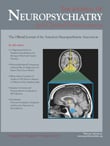Suicidal Ideation Secondary to Sodium Oxybate
To the Editor: Sodium oxybate is a derivate of gamma-hydroxybutyric acid (GHB). GHB is a short-chain fatty acid, a natural metabolite of the brainstem, with action as an inhibitory neurotransmitter or neuromodulator. Sodium oxybate is approved in Europe and considered the first-line therapy for the treatment of cataplexy in patients with narcolepsy-cataplexy syndrome, 1 and it is the only medication demonstrated to improve multiple major symptoms of the disease.
In randomized, double-blind, placebo-controlled clinical trials, sodium oxybate was well tolerated, and the side effects consisted mainly of dizziness, headache, nausea, urinary incontinence, or sleep disorders. 2 The drug has shown a safety side effect profile. 3
Considering that, the recent publication of three deaths associated with use of sodium oxybate has created important controversy. 4 We present the case of a patient with acute depression and suicide ideation secondary and dose-related to sodium oxybate.
Case Report
A 53-year-old man presented with a history of narcolepsy-cataplexy syndrome since he was 48 years old. He had excessive daytime sleepiness, sleep attacks, severe cataplexy, sleep paralysis, hypnagogic hallucinations, and lucid dreams. Polysomnography and the Multiple Sleep Latency Test confirmed the diagnosis. Testing for HLA DQB1*0602 was positive.
We treated the patient with sodium oxybate, 4.5 grams/night. One month later, as the patient still presented with cataplexy due to angry situations and excessive daytime sleepiness, we decided to increase sodium oxybate to 6 grams/night. Fifteen days later, the patient developed acute depression with suicidal ideation, saying “I do not want to live” and “I will kill myself, but I do not know how.” He even told his wife to hide the shotguns he had in his house.
We immediately decreased sodium oxybate to 4.5 grams/night, and his depression symptoms soon resolved. The patient was asymptomatic after 3 days. The case was communicated to the Spanish drug safety system (Register Number 15690).
Discussion
Adverse events, including coma or death, resulting from GHB abuse have previously been reported. 5 However, there are fewer papers published about the side effects of sodium oxybate as a therapeutic agent, and psychiatric alterations are not reported. However, those alterations are likely more commonly presented. In our clinical experience, among 17 patients treated with sodium oxybate, three developed psychiatric symptoms such as depression or severe anxiety. In all the cases, side effects appeared after a dosage increase from 4.5 to 6 grams/night, and we reduced or even stopped the treatment.
A pharmacokinetic profile of GHB shows a rapid absorption and metabolism with a steep dose-response curve; because of that there is a short line between therapeutic and toxic dose, justifying our findings. In conclusion, physicians should consider psychiatric alterations in narcolepsy-cataplexy patients treated with sodium oxybate as well as a careful clinical review and monitoring after dose changes.
1. Billiard M, Bassetti C, Dauvilliers Y, et al: EFNS guidelines on management of narcolepsy. Eur J Neurol 2006; 13:1035–1048Google Scholar
2. The US Xyrem Multicenter Study Group: A randomized, double blind, placebo-controlled multicenter trial comparing the effects of three doses of orally administered sodium oxybate with placebo for the treatment of narcolepsy. Sleep 2002; 25:42–49Google Scholar
3. Thorpy MJ: Sodium oxybate for the treatment of narcolepsy. Expert Opin Pharmacother 2005; 6:329–335Google Scholar
4. Zvosec DL, Smith SW, Hall BJ: Three deaths associated with use of Xyrem. Sleep Med 2009; 10:490–493Google Scholar
5. Knudsen K, Greter J, Verdicchio M: High mortality rates among GHB abusers in Western Sweden. Clin Toxicol 2008; 46:187–192Google Scholar



